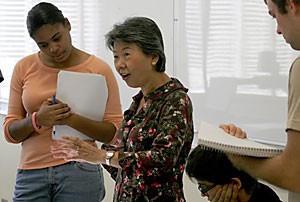A professor, a cook, a Program Faculty Fellow and a da Vinci Circle Fellow. Four people? No, just one.
Supapan Seraphin has been teaching at the UA since 1990, when she was the first woman hired in the Department of Material Science and Engineering, as a professor. She is now the director of electron microscopy and teaches a variety of classes for material science and engineering students.
This year, Seraphin was named a da Vinci Circle Fellow .
To become a Fellow, alumni supporters select faculty for their outstanding work around the UA, including research and outreach, she said.
They pick between one and three people, and those chosen are given $10,000 to support their research.
“”I was very pleased to be named a da Vinci Circle Fellow because only 10 percent of women are in engineering,”” she said.
In 2001, Seraphin joined the Faculty Fellows Program, which seeks to foster “”meaningful interaction between faculty and students in a non-classroom setting,”” according to a program brochure.
Seraphin, who grew up in Thailand, decided to cook Thai food for students and at first had around 30 or 40 takers. Now, she cooks for 120 or more students once a week.
“”I think I was picked (as a Fellow) because of my cooking,”” Seraphin said.
Seraphin described material science and engineering majors as people who create new materials to improve everyday things.
“”One example is a cell phone,”” she said. “”We make it smarter, lighter, better.””
If I were to take a photo of them now, you would see lips cracking, dark eyes, pimples and messy hair. I don’t want to sound like their mom, but I tell them they have to take care of themselves.
Supapan Seraphin, material science and
engineering professor
Many steps are involved in making materials better, and each one has to be done right, Seraphin said. She used baking a cake as an analogy, emphasizing the importance of correct oven temperature, proper ingredients and proper cooking time.
“”When I interview graduate students for my lab, I ask them, ‘Do you like to cook?’ “” she said. “”If they are good at cooking, then they will do well in MSE.””
This year marks Seraphin’s turn in her department to teach the freshman engineering class.
“”I take a picture of them when they first come in, to learn their names,”” she said. “”If I were to take a photo of them now, you would see lips cracking, dark eyes, pimples and messy hair. I don’t want to sound like their mom, but I tell them they have to take care of themselves.””
Seraphin’s care for her students has been noticed by people around her.
“”She knows how to connect with people on a personal basis,”” said Pat Elias, a College of Engineering and Mines administrative associate who has known Seraphin since the early 1990s. “”She brings a sense of community wherever she goes.””
Seraphin said she will probably use the Fellow money for a project she started in 1993 that deals with carbon nanotubes, very thin structures with a myriad of scientific uses.
For the project, she and several graduate students are growing nanotubes from a non-toxic substance – aloe vera extract – egg whites, coconut juice and many other organic substances.
“”We are making materials with a safer substance, and it is very exciting because we need to save our planet from the ground up,”” she said.
In Thailand, she said, the majority of women get their education in science. Yet most of the women go on to become teachers because the job is respectable.
When Seraphin had an opportunity to go to educational seminars in Japan and Italy, her life changed dramatically.
It was in Italy that Seraphin met her future husband, then a well-known UA professor.
Later, she applied to Arizona State University to be close to him. It helped that ASU had the world’s best material sciences engineering program at the time.
When she graduated from ASU, she applied to the UA under her maiden name.
“”I remember a graduate woman trying to get her Ph.D. at the UA in MSE, and she came up and thanked me for being the first woman hired in the department,”” Seraphin said.
Alongside Seraphin’s accomplishments lies a passion for teaching.
“”I love to teach,”” she said. “”It is the ultimate challenge to make (students) love to learn.””









